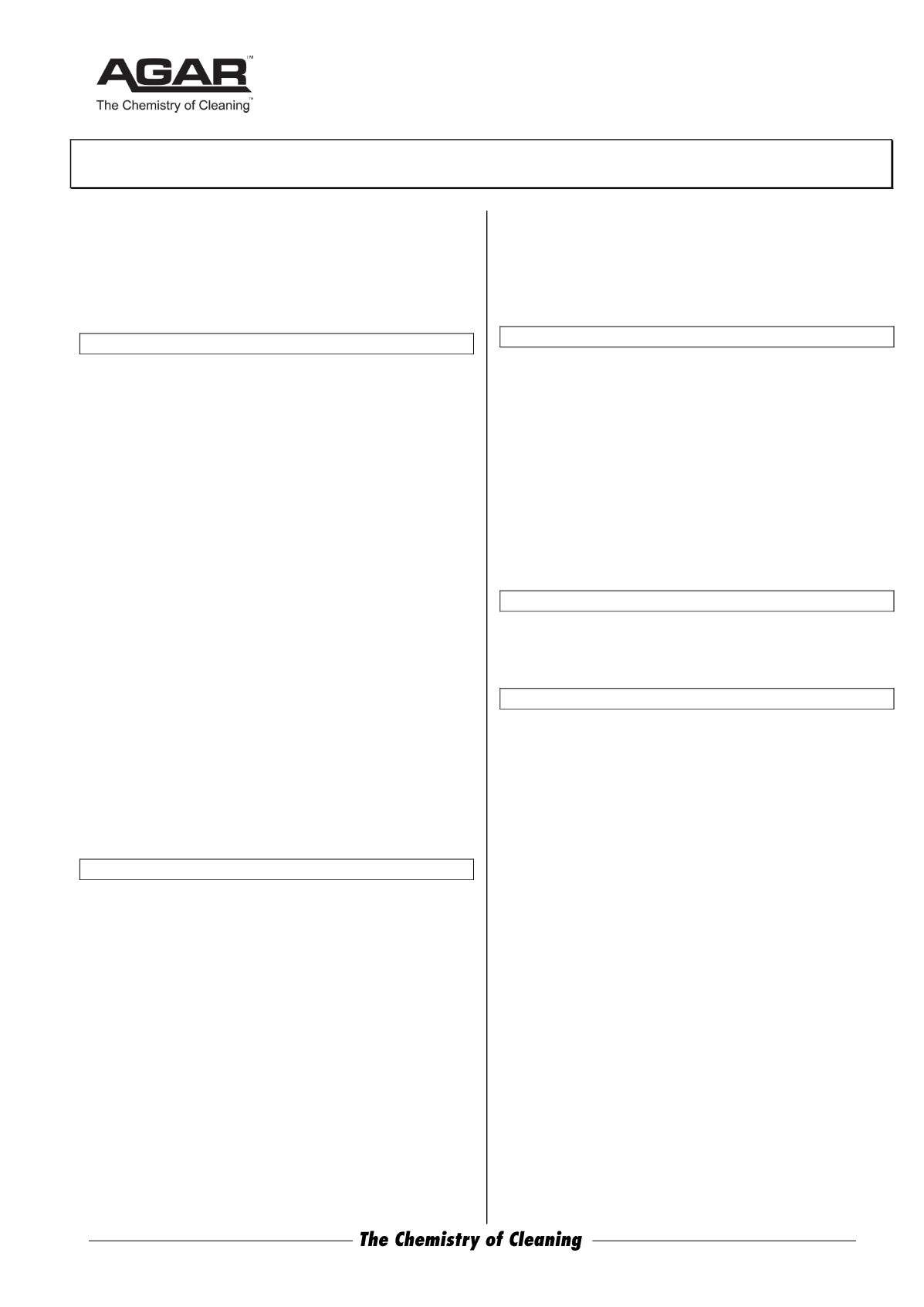

ABN 80 004 726 890 | MADE IN AUSTRALIA
Safety Data Sheet
Issued: December 21, 2015
Page 2 of 3
COUNTRY GARDEN
container. Wash the cleaned up area with copious volumes of
water to remove any trace amounts of product; ethanol mixes
completely with water.
Ventilate area well and ensure adequate personal protection as
above.
7 HANDLING AND STORAGE
Storage and Transport: Store in tightly closed containers in cool,
dry, isolated well ventilated areas away from heat, sources of
iginition and incompatibles. Do not eat, drink or smoke in
areas of use and storage. Observe State Regulations
concerning the storage and handling of Dangerous Goods.
Incompatibility (Materials to avoid for purposes of transport,
handling and storage only): Store with all precautions for
handling flammable liquids. The requirements of Australian
Standards AS 1940 - The Storage and Handling of
Flammable and Combustible Liquids should be observed. Not
to be loaded with Dangerous Goods of Classes 1, 2.1 (bulk),
2.3, 4.2, 5 and 7.
Handling: All electric equipment, including lighting, used in
proximity to storage of this product, and all electrical process
equipment used in any process involving ethanol should be
selected and installed in accordance with local wiring
regulations and the following Australian Standards:
AS 1020 The control of undesirable static electricity.
AS 1076 Code of practice for selection, installation and
maintenance of electrical apparatus and associated
equipment for use in explosive atmospheres (other than
mining applications) – Parts 1 to 13.
AS 2360 Electric equipment for explosive atmospheres –
Explosion – Protection Techniques.
AS 3000 Electrical Installations – Building, structures and
premises (known as the “SAA Wiring Rules”).
8 EXPOSURE CONTROLS / PERSONAL PROTECTION
Exposure Standards: The Exposure Standard recommended by
Safe Work Australia [NOHSC:1003(1995)] is:
ethanol: 1000 ppm 1800mg/cubic metre, time weighted
average (TWA)
Engineering Controls: Local exhaust and or mechanical
(general) exhaust is recommended, provided these are fitted
with flame and explosion proof electrical fittings.
Personal Protection:
Gloves - Avoid skin contact by the use of approved chemical
resistant gloves and aprons – PVC or Neoprene (AS 2161).
Note: Resistance of glove materials can vary. Evaluate
resistance under conditions of use and maintain PPE
carefully.
Eye protection - Avoid eye contact by wearing splash resistant
monogoggles or face shield (AS/NZ 1336) whenever
exposed to vapour or mist if there is a risk of splashing liquid
in the eyes. Safety showers with eye wash should be
provided in all areas where product is handled.
Respiratory - None should be needed under normal
circumstances. In high vapour concentration such as empty
vessels or confined spaces, use air supplied hood, or if
ethanol concentration likely to exceed 500ppm, wear an
approved organic vapour respirator (AS/NZ 1715 and 1716).
9 PHYSICAL AND CHEMICAL PROPERTIES
Appearance: Clear fluorescent pink liquid
Odour: Strong pot-pourri perfume
pH = Not applicable
Vapour Pressure: N/K
Vapour Density: N/K
Flash Point (Abel) : 13
°
C
Boiling Point: Approx. 78
°
C
Freezing Point: < 0
°
C
Solubility in water: Dispersible
Specific Gravity (20ºC) : 0.8
Evaporation rate: 253 (n-BuAc = 1)
% Volatile by vol: > 80%
10 STABILITY AND REACTIVITY
Stable.
Hazardous polymerization: None.
11 TOXICOLOGICAL INFORMATION
Health Effects:
Acute -
Swallowed:
Unlikely under normal occupational exposures, but
swallowing ethanol may cause harmful central nervous system
effects. Effects may include excitation, euphoria, headache,
dizziness, drowsiness, blurred vision, fatigue, tremors,
convulsions, loss of consciousness, coma, respiratory arrest
and death. Severe acute intoxication may cause
hypoglycaemia, hypothermia and extensor rigidity. Other
effects may include decreased blood pressure, vomiting blood,
and blood changes. Aspiration into the lungs may cause
pneumonitis.
Eye:
Vapours may irritate the eyes. Liquid and mists may
severely irritate or damage the eyes.
Skin:
Moderately irritating to the skin. Brief contact may cause
redness. Repeated or prolonged contact may lead to
dermatitis with redness, itching, swelling and possible
secondary infection. May cause sensitization of the skin by
skin contact.
Inhaled:
Moderately irritating to respiratory tract and mucous
membranes. Inhalation of the vapour may result in headaches,
nausea and vomiting. High concentrations may cause central
nervous system symptoms similar to “swallowed” above.
Health Effects -
Chronic
:
Chronic irritation by swallowing or repeated inhalation may
cause degenerative changes to the liver, kidneys, hair,
gastrointestinal tract and heart muscles.
Please turn to page 3


















